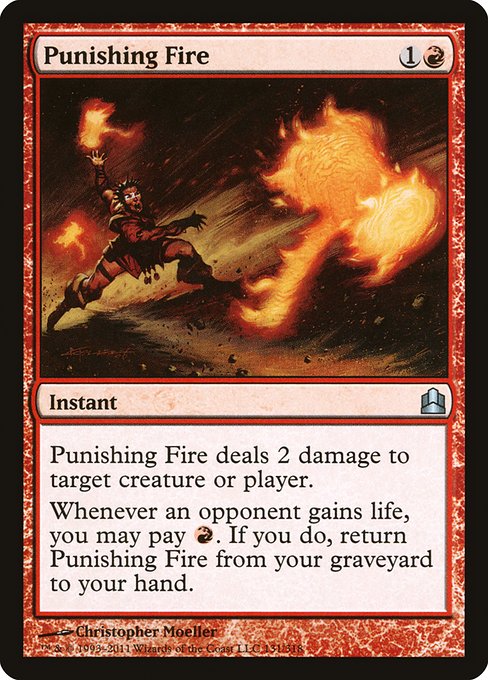
Image courtesy of Scryfall.com
A Red Instant That Keeps the Table Honest
Punishing Fire is a deceptively simple spell with a core premise that resonates in casual play: deal 2 damage to any target for a mere mana investment of {1}{R}, and then lean on a life-gain engine that can turn a single card into a recurring problem for your opponents. In multi-player kitchen-table circles and laid-back Commander tables alike, you’ll see how this little instant can swing momentum in ways that feel both tactical and a little cheeky 🧙♂️🔥. The card’s rarity—uncommon—and its Commander 2011 reprint pedigree mean it’s well within reach for casual decks, budget-friendly to bolt onto a red strategy without the pressure of serious competitive play.
Punishing Fire deals 2 damage to any target. Whenever an opponent gains life, you may pay {R}. If you do, return this card from your graveyard to your hand.
That line of text, baked into a two-mana spell, invites a very specific kind of tempo game. You’re not just burning a threat or a blocker; you’re laying the groundwork for a potential back-and-forth where lifegain from others fuels your card’s own resurrection. In casual formats, where lifegain themes are common, this can feel like a conversation with the table: “If you gain life, I’ll return Punishing Fire and keep poking the table with red-hot damage.” That dynamic, layered with the social politics of multiplayer games, is part of what makes Punishing Fire memory-worthy 🧨🎲.
Why it fits the casual vibe so neatly
- Accessibility meets durability: The mana cost is gentle for red decks, and the effect isn’t one-shot. In casual play, you’ll often have chances to return Punishing Fire from your graveyard after an opponent’s life gain trigger, creating a recognizably stubborn engine.
- Life gain as a social lever: Casual tables frequently feature lifegain from multiple players—whether through politics, combo-adjacent cards, or just long, grindy games. Punishing Fire rewards that environment by turning lifegain into a recurring threat on players you’re aiming at, not just the board—making the life totals part of the table’s storyline 🧙♂️💎.
- Low-cost value with a dash of nostalgia: Being a reprint from a Commander set, it’s familiar to veteran players and approachable for newer ones. The art by Christopher Moeller conjures a vivid sense of heat and consequence, a flavor boost that casual groups adore 🎨.
- Flexibility in Casual Formats: While not legal in every format, it has a home in Legacy and Vintage play, and in Commander (the set label explicitly ties to casual and elective multiplayer games). That versatility makes it a talking point at table-side strategy discussions 🧭⚔️.
Deckbuilding tips for casual tables
If you’re intrigued by Punishing Fire’s promise, here are practical ways to weave it into your casual deckbuilding without chasing perfection:
- Encourage lifegain triggers: In a multi-player game, you’ll often encounter moments when an opponent gains life. Cards like lifegain enablers or political effects can create natural opportunities to flash Punishing Fire back into action. It’s not about stacking lifegain; it’s about leveraging the moment to recycle a threat that keeps pressuring the table 🧙♂️🔥.
- Graveyard resilience matters: Since the recast mechanism relies on Punishing Fire returning from your graveyard, decks that help you keep a graveyard stocked (or simply protect it from being emptied) can improve consistency. Think red tools that protect, tutor, or grant inevitability, while keeping the gravitational pull of the life gain trigger in mind.
- Target choice is strategic: The card can be directed at any target. On crowded boards, you’ll often want to pressure a player who’s climbing the life total barometer or a problematic blocker who’s stabilizing. The dread is not just life loss; it’s the expectation that Punishing Fire may return to the hand when life gain happens and keep the pressure relentlessly applied 💥.
- Sync with your table’s tempo: If your group enjoys long, social grind sessions, Punishing Fire becomes an ongoing conversation piece. It’s a neat, budget-friendly engine that rewards patient play and careful timing more than brute force — a hallmark of many classic red lists 🧩.
A note on lore, design, and value
The card’s artwork and flavor align with a red-tinged theme of heat, danger, and consequences. Christopher Moeller’s illustration carries the sense that every life gain moment is paid for in a furnace of consequence—an idea that resonates in formats where players bargain with each other and with fate itself. Rarity-wise, Punishing Fire’s uncommon status in Commander 2011 reflects its role as a solid, recognizable staple rather than a once-in-a-blue-moon inclusion. In today’s market, its value shows up modestly in casual decks and budget builds, but the memory it evokes for players who cut their teeth on early 2000s era red strategies carries a different kind of worth 🧡💎.
Why it remains a talking point in casual circles
Casual MTG thrives on stories, table talk, and a little chaos. Punishing Fire embodies all three: a compact burn spell that rewards mindfully played lifegain triggers, a graveyard recursion trick that tests your sequencing, and a dash of nostalgia radiating from a Commander-era design. It’s not about overpowering the table; it’s about enabling a recurring, interactive gameplay arc that keeps everyone involved and invested. For players who love the red school of inevitability and the drama of lifegain politics, Punishing Fire is a patient flame that refuses to go out 🔥🧙♂️.
Pro tip for fans who want a tactile, social experience: pair a Punishing Fire-heavy approach with a thematic accessory—a personalized mouse pad that mirrors your play style. The product linked below isn’t just a promo; it’s a nod to the hobby’s tactile rituals. The way a good gaming surface feels under a fevered hand can be part of the game’s charm, especially when you’re courting table talk and friendly rivalry.